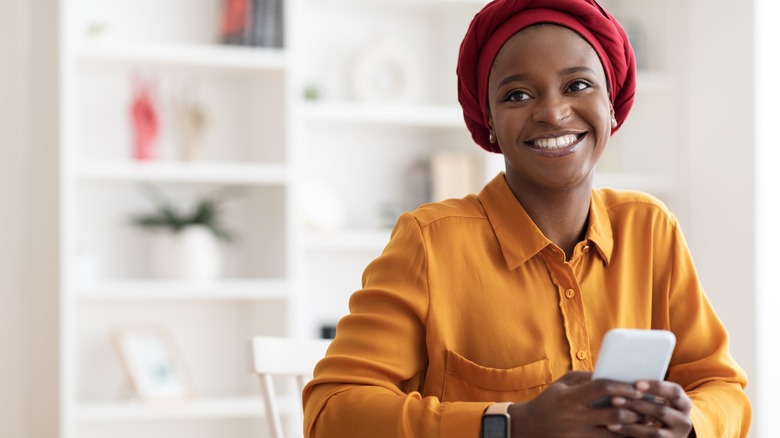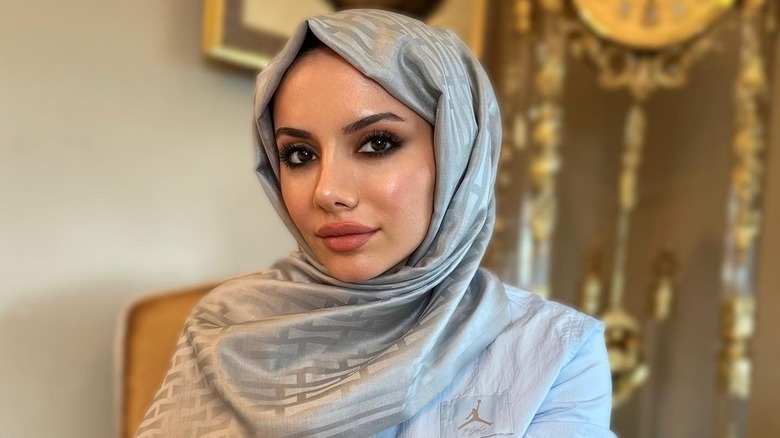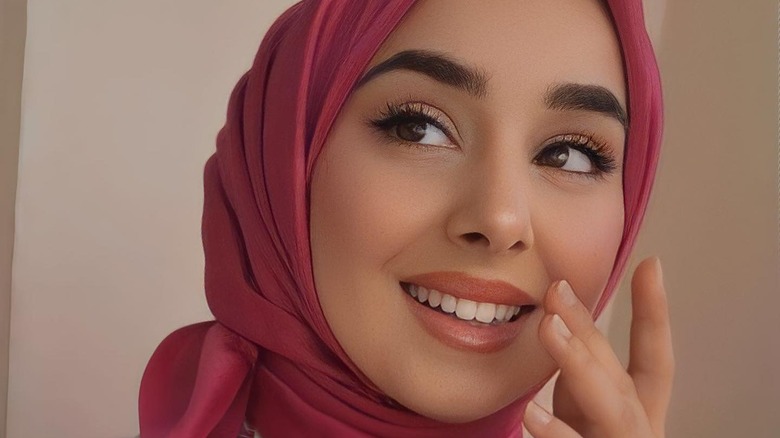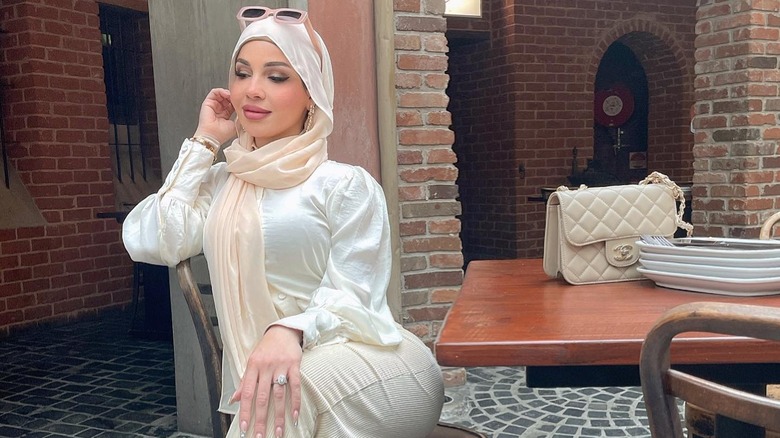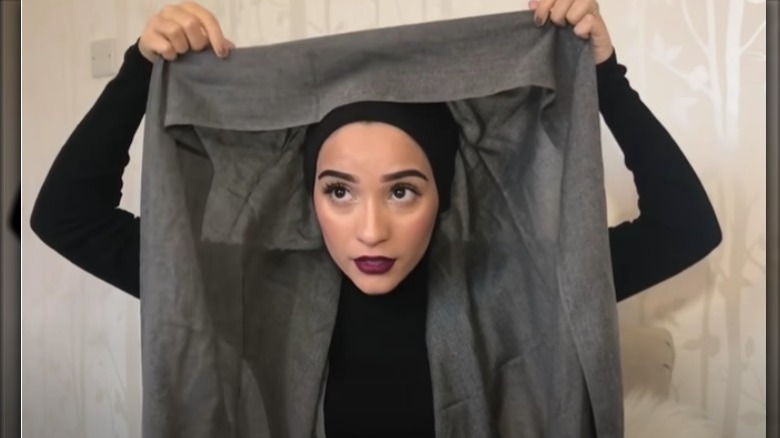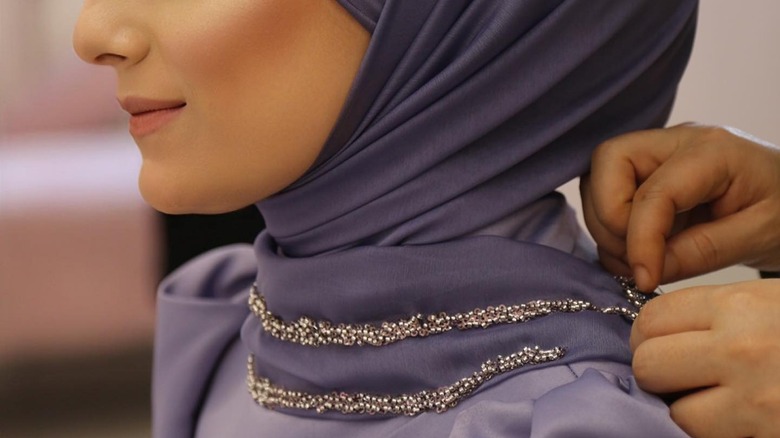How You Can Style Your Hijab Scarf Based On Your Face Shape
Women from all of the world's major religions occasionally wear head coverings, wigs, or scarves either for modesty, to signal their faith, or as a long-held cultural tradition. Because a head scarf is a public signal of private identity, modern women of all ages might choose to combine this more traditional expression with a sense of fun, color, and accessories that emphasize their individuality.
While the mainstream fashion industry has admittedly been slow to become more inclusive toward hijab-wearing Muslim women, in one example of progress, some years ago designer Donna Karan launched a Ramadan collection. Other major Western designers have shown hijab-like head coverings on the runway with varying degrees of success.
Choosing to wear the hijab is a deeply personal choice, but that doesn't mean it can't also be a fashionable one. When you style your hijab with your face shape in mind, you can beautifully frame and accent your features, ensuring your face becomes the shining star of your look, whatever that may be.
What's your face shape?
There are six basic shapes. They are heart, oval, rectangular, round, square, and diamond-shaped. Although there's some overlap, most of us fit primarily into one category over another.
Not sure which one you are? Grab the kind of soft measuring tape you might find in a sewing kit and measure your face. What you want to look at is the length from your hairline to your chin and your face's width. For width, you can measure in two places — across the widest point of your jaw, and from cheek to cheek. Look closely — what is the shape of your jawline?
Then you'll compare the two. If your face is longer than it is wide, it's probably an oval. If the measurements are more or less equal, it could be round. A good first step to figuring out your face shape is to pull all your hair back to see a clear outline. Take a picture of yourself, make your best guess about what face shape you have, and compare it to celebrities who have the same shape.
Get your colors done
In addition to wrapping according to face shape, the art of styling your hijab includes choosing colors that are genuinely flattering and make you feel happy and uplifted as you wear them. For example, it's the rare person who can frame herself in all-black and still feel energized. Many people look flat and drained or feel low energy in solid black. One exception is people who are classified as "winters" in seasonal color analysis. A winter's features pop when they wear black.
What season are you? Have you ever had your colors professionally analyzed? Color analysis is an industry in itself and it takes a painter's eye and excellent training to get the nuances right. This is just a brief overview. Although there are eight more defined sub-categories, people are generally classified as winter, spring, summer, or autumn. Three factors that analysts take into account are eye color, hair color, and skin tone.
All hues of skin are on a spectrum of cool to warm. Two people with the same skin shade could be considered completely different seasons if one has warm undertones, and the other is cooler. Warmth and coolness in the skin directly affect what colors look good on us, especially when fabric drapes completely around your face. Mikaela Carrizo helps women improve their image and personal style, and she's got a detailed color analysis tutorial on YouTube. When working with a color analyst, conduct your session in person for the best results.
Take your cues from the time of year and fabric choices
If you're new to wearing a hijab or simply revamping your existing style, it's good to consider the temperature and, if you live in a climate that varies, the different seasons. Take comfort into account. Cotton is perfect when it's warmer out, and as a natural fiber, it's highly breathable, lightweight, and easy to work with. Silk has similar qualities, but remember that silk garments have a more fluid drape and less structure than cotton.
Cotton interwoven with silk is a great combination. It's still lightweight, but there's a bit more structure to play with. Satin is more trouble than it's worth. Try chiffon instead.
Some synthetic fabrics are more affordable than natural textiles, but make sure they're truly comfortable. Synthetics can be heavy, they don't breathe, causing you to perspire, and the shiny polyesters that resemble satin are too slippery to work with.
Ways to wrap
Now that you've identified your face shape and colors that work, it's time to start experimenting. As you already know, you're always striking a balance between wrapping too loosely or too tightly. If it's too loose, you'll spend the day readjusting your hijab, and if it's too tight, your breathing might be constricted and your natural hairline will look cramped up when you're back at home. Here are a few guidelines.
If you have a round or an oval face, chances are you'll look great in every style of drape. If your face shape is square, heart, rectangular, or diamond, what you'll want to pay attention to is the point on your face where you make folds. This will take experimenting in front of the mirror, and you can follow along with Hira Noor in her easy YouTube wrapping tutorial. Think of the way a great designer cuts and drapes the fabric of a dress on a woman to either accentuate an area, like a small waist, or uses color, patterns, or draping to draw attention away from another area.
Where you make sharp little folds in your hijab — near the eyes, just above the nose tip, lower along the jaw line, or cleanly under the chin — makes slightly different shapes with the fabric that fool the eye, creating either the illusion of more width or shapes that highlight your features. Also, notice how wrapping fabric over your head creates extra volume, and how bringing fabric over your chest creates a different effect than draping it behind you.
Elevate your look with cute accessories
Because of the many folds and the volume of hijab fabric, if you're going to use accessories beyond a decorative pin, consider going bold. Brooches can add sparkle while also keeping your scarf secure. You can try a necklace with larger pendants over the front of the hijab so it stays visible. Some people drape a necklace on top of their heads, like a tiara, which is feminine and charming.
To learn more about face shapes and jewelry, this article about the best jewelry for rectangular faces can give you ideas that you can learn from regardless of your face shape. For example, if your face is rectangular, long earrings make your face look longer, and square earrings can be too severe. A good solution is to use rounded, soft accessories and short necklace lengths.
In the same way, borrow the idea of contrasting shapes as you wrap your hijab. For a rectangular face, consider pulling the hijab and cap down your forehead to just above the eyes to reduce the appearance of length. Have fun experimenting with folding, volume, and sparkle to show off your beautiful face.
